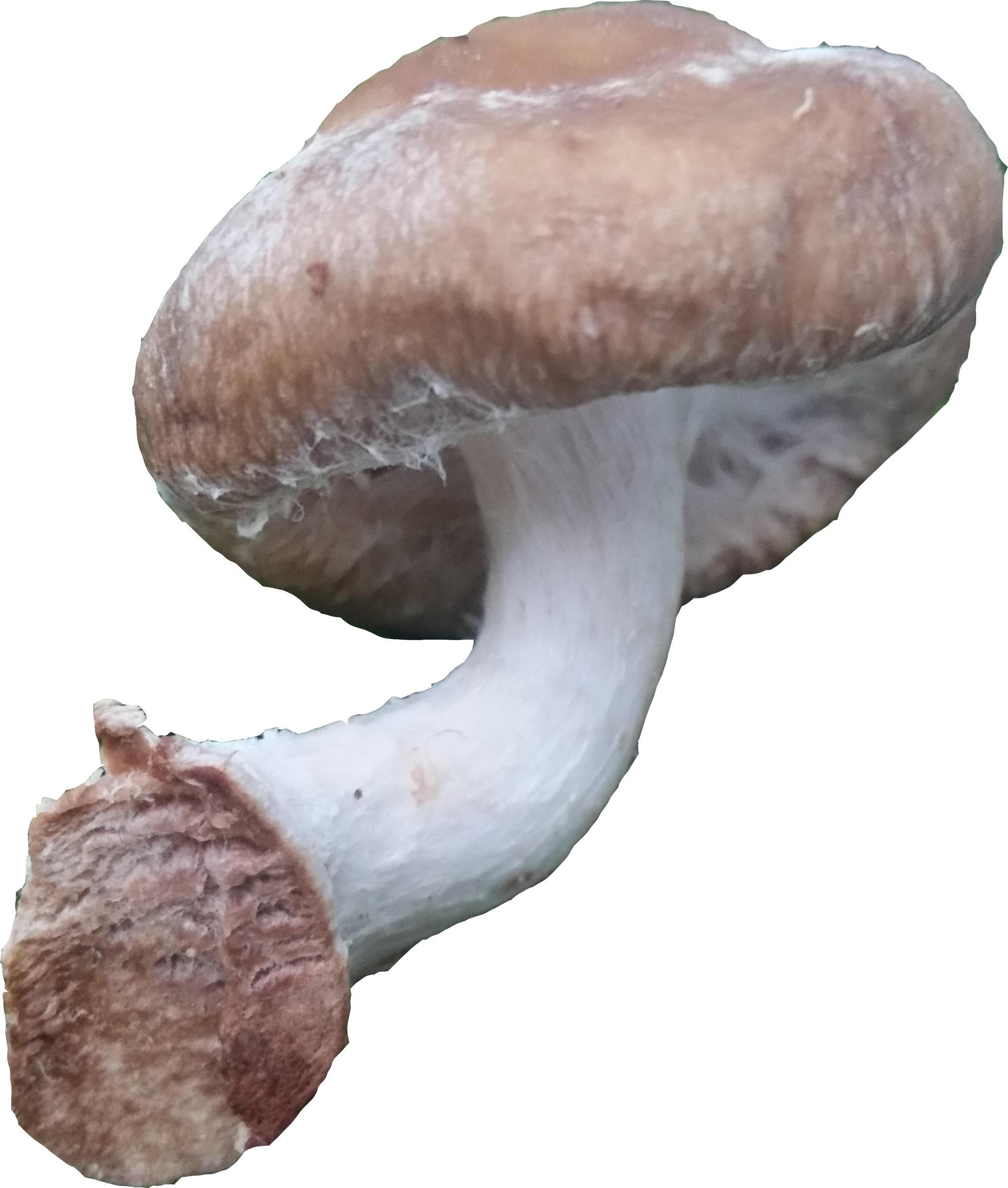Shiitake mushrooms (Lentinula edodes) are grown around the globe. Their rich texture, smoky flavor, and nutritious components have made them the second most commonly cultivated edible mushroom in the world. Originally cultivated by the Japanese, the name shiitake is composed of shii, for the Japanese chinquapin (Castanopsis cuspidate), the species of choice for growing shiitake mushrooms in Japan, and take, meaning mushroom.
Shiitake characteristics and life cycle
The shiitake has an umbrella-shaped cap that is tan to brown in color. The edges of the cap roll down and inwards towards the whitish, cream-colored gills on the underside of the cap. The stem of the shiitake is also white or cream but can turn brown as the mushroom grows larger.
Shiitakes begin their life cycle as an invisible network of mycelium, a mass of tiny, threadlike structures called hyphae, which feed on the wood of hardwood tree species. The shiitake mycelium digest wood cellulose and lignin and use the resulting nutrients to grow. Once this process is complete, the fungus will produce a fruiting body, also known as a mushroom. In the wild, this mushroom will release spores that will travel to other log substrates and begin the process over again.
How to cultivate your own shiitakes
Start by finding the perfect home for your shiitakes to grow and thrive. This should come in the form of a quality host log. The host log is ideally felled in the fall or winter when it is full of sugar, its bark tight, and its moisture content high.
Sugar maple or white oak trees are preferred, but most any hardwood species will work unless they are resistant to decay, like black locust or walnut. Length should be 12 inches or greater. Diameter can be 2.5 to 7 inches.
Inoculation
To mimic the shiitake’s natural life cycle, begin by injecting spores into the host log—a process known as inoculation. Inoculate within 15 to 30 days after the tree or branch has been cut. Shiitake does not compete well with other fungi, so the sooner the log is inoculated, the less likely other fungus species are to infect the log. Select only healthy branches or logs with all bark intact. You will use shiitake spore cultures, called spawn, to inoculate your log. Commercial growers sell the spawn in dowel plugs or in sawdust. There are many different types of spawn strain, so be sure to pick one that is suited to the environment you will be growing in.
To inoculate the logs, drill holes in the host log using a 5/16-inch drill bit if using dowel spawn, and 7/16-inch drill bit if using sawdust spawn. Each hole should be 1 inch deep. Sawdust spawn is cheaper and may produce shiitakes more rapidly but requires a special inoculation tool. Dowel spawn is more tolerant to low moisture levels and don’t require any special tools. Drill holes beginning 1 or 2 inches from the edge of the log and space the holes 3 to 6 inches apart in a row, with 2 or 3 inches between each row. This will create a diamond pattern that evenly covers the log and allows the mycelium to spread along the grain of the wood. Spray water into each hole if moisture content is a concern. After the dowel spawn or sawdust spawn has been placed into each hole, cover each inoculated hole with food-grade wax to block birds, slugs, or other fungi from getting in and to keep the hole moist. Place the inoculated log in a damp, cool area that has some air flow but is protected from direct sunlight and the wind. Stack the logs Lincoln log style on top of each other, or lean them against something, keeping as much of the log as possible off the ground.
Spawn run
Over the next 6 to 18 months, the spawn will grow into mycelium and spread throughout the log substrate. The timing is dependent on the tree species, moisture content, log size, spawn substrate, air temperature, and other variables. It is important to maintain the log’s high moisture content. The simplest way to ensure this is to water your log if it has not received any natural precipitation for about 5 days. Once the mycelia start to appear at the end of the log, the spawn run is complete and harvest time is near.
Harvest
When the shiitake mycelium is visible at the cut ends of the log, the shiitake will begin producing baby mushrooms, called pinheads, within three days. The pinheads will originate where the white mycelia have begun to show on the log. In approximately 5 days, full-grown mushrooms will be ready to harvest. To harvest shiitakes, twist them at the base of the stem and pull. Continue to harvest daily until no more mushroom production is occurring. These logs will produce mushrooms every 6 to 18 months for 5 to 7 years.
Forced fruiting
If you want mushrooms at a more rapid pace, you can try force fruiting your logs. After the first natural fruiting of your log, wait 10 to 12 weeks and soak your logs in a cold-water bath, if using a warm weather strain, and in warm water, if using a cold weather strain. This will simulate a change in season, and fruiting will occur within 2 to 4 days. This process can be repeated every 10 to 12 weeks.
© 2017 Oregon State University
Published and distributed in furtherance of the Acts of Congress of May 8 and June 30, 1914, by the Oregon State University Extension Service, Washington State University Extension, University of Idaho Extension, and the U.S. Department of Agriculture cooperating. The three participating Extension services offer educational programs, activities, and materials without discrimination on the basis of race, color, national origin, religion, sex, gender identity (including gender expression), sexual orientation, disability, age, marital status, familial/parental status, income derived from a public assistance program, political beliefs, genetic information, veteran’s status, reprisal or retaliation for prior civil rights activity. (Not all prohibited bases apply to all programs.) The Oregon State University Extension Service, Washington State University Extension, and University of Idaho Extension are an AA/EOE/Veterans/Disabled.



